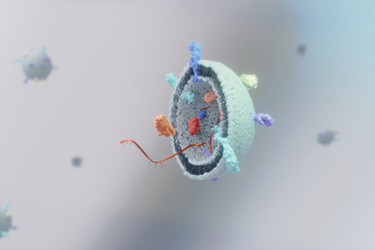Redefining CGT With Exosomes And EVs

By Erin Harris, Editor-In-Chief, Cell & Gene
Follow Me On Twitter @ErinHarris_1

July’s Cell & Gene Live, Redefining CGT with Exosomes and EVs, featured my discussion with expert our panelist, Dr. Gloria Matthews, Chief Medical Officer at Aegle Therapeutics. During the hour-long presentation, Dr. Matthews shared how extracellular vesicle (EV) and exosome-based therapies are rapidly gaining attention as a new frontier in regenerative medicine. These tiny, cell-derived particles offer the potential to revolutionize treatments for a range of conditions from severe burns to rare genetic skin disorders. Indeed, Dr. Matthews provided a comprehensive look at the scientific advances, clinical promise, manufacturing hurdles, and regulatory considerations shaping this field.
Harnessing the Full Spectrum of EVs
Aegle Therapeutics distinguishes itself by developing therapies from bone marrow-derived mesenchymal stem cell (MSC) EVs, which include exosomes as well as other vesicle types. Unlike many companies that focus solely on exosomes, Aegle believes that the broader mix of vesicles offers a richer opportunity of regenerative and immunomodulatory factors. This approach is rooted in the observation that the therapeutic benefits seen with stem cell therapies can often be attributed to the vesicles those cells release rather than the cells themselves.
The company’s lead clinical programs target two main indications:
- Burns: Aegle’s initial clinical work focuses on deep second-degree burns, aiming to accelerate healing, minimize scarring, and preserve function. Early patient experiences have shown promising results with rapid wound closure and improved outcomes compared to untreated areas.
- Epidermolysis Bullosa (EB): This rare, severe blistering disorder is caused by a deficiency of collagen VII and immune dysregulation. While gene therapies targeting collagen VII have shown some success, Aegle’s EV-based approach aims to address both the genetic and immunological aspects of the disease, potentially offering broader benefits.
Manufacturing Innovations for EVs
One of the most significant challenges in bringing EV-based therapies to patients is manufacturing. Scaling up production from laboratory to clinical and commercial levels requires overcoming issues such as yield loss during filtration and maintaining batch consistency. Aegle and other innovators are adopting advanced techniques like bioreactors and tangential flow filtration to improve yields and product consistency. Despite these advances, manufacturing remains a bottleneck, especially for systemic applications that demand larger doses.
Mechanism of Action
Aegle uses native, unmodified EVs, which carry a complex cargo of proteins, RNAs, and other bioactive molecules reflective of their stem cell origin. These vesicles rapidly fuse with local cells at the site of application, delivering their contents and triggering regenerative and immunomodulatory processes. While the precise mechanisms are still being elucidated, the broad spectrum of factors within the Evs is believed to drive their therapeutic effects.
Clinical Applications: Advantages and Differentiation
Dr. Matthews explained how EV-based therapies offer several advantages over traditional small molecules, biologics, and even cell therapies:
- Rapid Cellular Fusion: EVs quickly integrate with target cells, efficiently delivering their therapeutic cargo.
- Reduced Immunogenicity: Compared to engineered viral vectors or lipid nanoparticles, EVs are less likely to provoke immune responses, making them attractive for repeated or systemic administration.
- Versatility: EVs can be used for both local and potentially systemic delivery, though the latter presents greater manufacturing and dosing challenges.
MSC-derived exosomes offer a relatively consistent therapeutic profile though some donor variability persists. Aegle’s proprietary extraction and purification methods are designed to maximize consistency and potency, setting them apart in a competitive landscape.
Inside Manufacturing and CMC Challenges
Ensuring batch-to-batch consistency is a persistent challenge due to biological variability among donors and the complexity of the manufacturing process. Aegle addresses this by applying strict donor selection criteria and standardized manufacturing protocols. Nevertheless, some variability is inevitable, and broader product specifications may be necessary compared to traditional pharmaceuticals.
Scaling up production to meet clinical and commercial demand is a primary hurdle, particularly for systemic indications that require higher doses. Closed system manufacturing is seen as critical for ensuring sterility and product safety while full automation remains unlikely in the near term due to the nuanced “art” involved in cell-based manufacturing.
EV-Specific Challenges in the Regulatory Landscape
Regulatory authorities require robust potency assays to demonstrate product efficacy and stability. However, the lack of standardized, predictive assays for EV products complicates the approval process. Aegle’s strategy involves developing indication-specific, orthogonal assays and engaging early with regulators to align on requirements. The regulatory path for EVs is generally considered less onerous than that for gene therapies or viral vectors, but it still presents unique challenges due to the complexity and novelty of the products.
EVs in the Commercial Landscape
Aegle is among a small group of companies with clinical-stage EV therapies, particularly in dermatology. Most competitors are focused on other areas, such as neurodegenerative diseases or systemic inflammatory disorders. Their use of the full spectrum of EVs and proprietary manufacturing processes are key differentiators.
Currently, CDMOs play a vital role in supporting small biotech companies such as Aegle Therapeutics. As the field matures and larger pharmaceutical companies enter the space, some manufacturing may shift in-house, but Dr. Matthews believes CDMOs are likely to remain important for the foreseeable future.
Future Directions and Key Drivers for EV-Based Therapies
The next few years will be critical for EV-based therapies. Dr. Matthews stated drivers of success include:
- Manufacturing Breakthroughs: Improved scalability and consistency are essential for broader adoption and commercial viability.
- Regulatory Approvals: The first approved EV-based therapies will pave the way for others, establishing precedents and regulatory comfort.
- Assay Development: Better potency and stability assays will facilitate both regulatory approval and product optimization.
- Dosing and Formulation: Optimal dosing regimens and alternative formulations (such as ointments) are still being explored, with current data supporting long shelf life in aqueous suspensions.
Exosome and EV-based therapies represent a promising new class of regenerative and immunomodulatory treatments. Continued innovation in production, assay development, and regulatory strategy will be essential for realizing the full promise of these therapies across many indications. Be sure to view the full-length presentation here.
